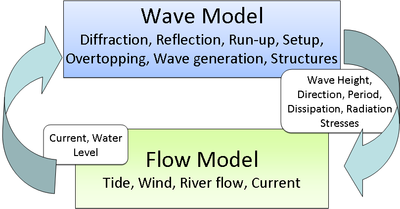Model Coupling
Introduction

CMS-Flow and CMS-Wave can be run separately or coupled together using a process called steering. The variables passed from CMS-Wave to CMS-Flow are the significant wave height, peak wave period, wave direction, wave breaking dissipation, and radiation stress gradients. CMS-Wave uses the update bathymetry, water levels, and currents from CMS-Flow. The time interval at which CMS-Wave is run is called the steering interval. Currently in CMS the steering interval is constant and the input spectra in CMS-Wave must be at constant intervals without any gaps. In CMS versions less than 4.0, the steering process is controlled in the SMS interface using communication files because the CMS-Wave nd CMS-Flo models where separate executables. In CMS v4.0, both CMS-Flow and CMS-Wave are contained within a single executable (inline) and the steering process is controlled by an interval steering module. The advantages of the inline steering are that the model runs faster because there is no need to use communication files or reinitialize the models (memory allocation, variable initialization, etc.), makes the improvement and maintenance of the steering module easier for the developers, and also makes the code more portable to other operating systems. The inline steering process is as follows:
- CMS-Wave model is run for the first two time steps (time = and time = ) and the wave information is passed to CMS-Flow.
- The wave height, period, wave dissipation, radiation stress gradients, and wave unit vectors are interpolated spatially from the wave grid to the flow grid.
- CMS-Flow runs from time = until time = and interpolates the wave variables from during the simulation. During the flow
- The water levels and current velocities are estimated for time = and interpolated from the flow grid to the wave grid.
- CMS-Wave is run again for time = and
- The process is repeated over until the end of the simulation.
Prediction of Water Levels and Currents
Because CMS-Wave requires the water surface elevation at times that are ahead of the hydrodynamics, the water surface elevation and currents. If the steering is relatively small (~<30 min), than the values from the previous time step may be used without significant error.
| (1) |
| (2) |
| (3) |
where n is the steering time step (CMS-Wave time step). However, in many coastal engineering projects it is desirable and common to use relatively large steering intervals of 2-3 hours and 3 hours is especially common since many wave buoy data products are at 3 hour intervals. Over large steering intervals, the change in water depth has the largest influence on the nearshore wave heights. Therefore, when using large steering intervals, it is desirable to make a better prediction of water levels than using the previous time step.
In cases where the relative surface gradients at any time are much smaller than the mean tidal elevation, a better approximation of water level may be obtained by decomposing the water level into
| (4) |
where is the mean water level, and is the component due to tidal, wave, and wind generated surface gradients. can be estimated from water level boundary conditions and is generally much larger, so may be neglected. For some cases in which the surface gradients do not vary significantly over time (open coast beach), the second term may be approximated as
| (5) |
| Symbol | Description | Units |
|---|---|---|
| Water surface elevation | m |